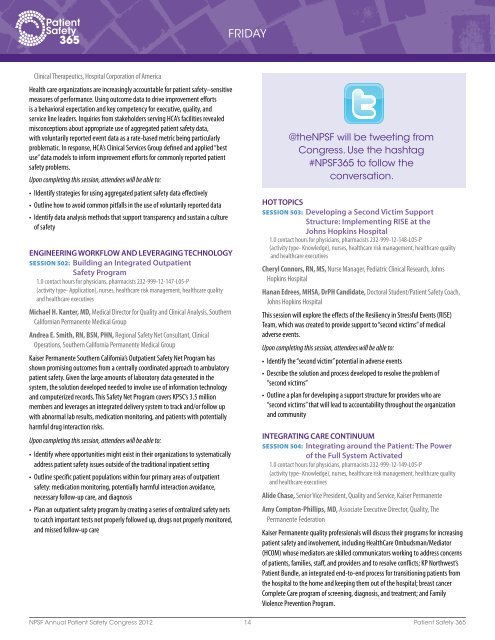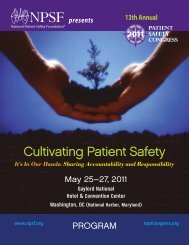NPSF Research Grants Program - NPSF Patient Safety Congress
NPSF Research Grants Program - NPSF Patient Safety Congress
NPSF Research Grants Program - NPSF Patient Safety Congress
Create successful ePaper yourself
Turn your PDF publications into a flip-book with our unique Google optimized e-Paper software.
Clinical Therapeutics, Hospital Corporation of America<br />
Health care organizations are increasingly accountable for patient safety–sensitive<br />
measures of performance. Using outcome data to drive improvement efforts<br />
is a behavioral expectation and key competency for executive, quality, and<br />
service line leaders. Inquiries from stakeholders serving HCA’s facilities revealed<br />
misconceptions about appropriate use of aggregated patient safety data,<br />
with voluntarily reported event data as a rate-based metric being particularly<br />
problematic. In response, HCA’s Clinical Services Group defined and applied “best<br />
use” data models to inform improvement efforts for commonly reported patient<br />
safety problems.<br />
Upon completing this session, attendees will be able to:<br />
• IIdentify strategies for using aggregated patient safety data effectively<br />
• Outline how to avoid common pitfalls in the use of voluntarily reported data<br />
• Identify data analysis methods that support transparency and sustain a culture<br />
of safety<br />
ENGiNEERiNG WORkFLOW AND LEvERAGiNG tEChNOLOGY<br />
SeSSion 502: Building an integrated Outpatient<br />
<strong>Safety</strong> <strong>Program</strong><br />
1.0 contact hours for physicians, pharmacists 232-999-12-147-L05-P<br />
(activity type- Application), nurses, healthcare risk management, healthcare quality<br />
and healthcare executives<br />
Michael H. Kanter, MD, Medical Director for Quality and Clinical Analysis, Southern<br />
Californian Permanente Medical Group<br />
Andrea E. Smith, RN, BSN, PHN, Regional <strong>Safety</strong> Net Consultant, Clinical<br />
Operations, Southern California Permanente Medical Group<br />
Kaiser Permanente Southern California’s Outpatient <strong>Safety</strong> Net <strong>Program</strong> has<br />
shown promising outcomes from a centrally coordinated approach to ambulatory<br />
patient safety. Given the large amounts of laboratory data generated in the<br />
system, the solution developed needed to involve use of information technology<br />
and computerized records. This <strong>Safety</strong> Net <strong>Program</strong> covers KPSC’s 3.5 million<br />
members and leverages an integrated delivery system to track and/or follow up<br />
with abnormal lab results, medication monitoring, and patients with potentially<br />
harmful drug interaction risks.<br />
Upon completing this session, attendees will be able to:<br />
• Identify where opportunities might exist in their organizations to systematically<br />
address patient safety issues outside of the traditional inpatient setting<br />
• Outline specific patient populations within four primary areas of outpatient<br />
safety: medication monitoring, potentially harmful interaction avoidance,<br />
necessary follow-up care, and diagnosis<br />
• Plan an outpatient safety program by creating a series of centralized safety nets<br />
to catch important tests not properly followed up, drugs not properly monitored,<br />
and missed follow-up care<br />
FRIDAY<br />
@the<strong>NPSF</strong> will be tweeting from<br />
<strong>Congress</strong>. Use the hashtag<br />
#<strong>NPSF</strong>365 to follow the<br />
conversation.<br />
hOt tOPiCS<br />
SeSSion 503: Developing a Second victim Support<br />
Structure: implementing RiSE at the<br />
Johns hopkins hospital<br />
1.0 contact hours for physicians, pharmacists 232-999-12-148-L05-P<br />
(activity type- Knowledge), nurses, healthcare risk management, healthcare quality<br />
and healthcare executives<br />
Cheryl Connors, RN, MS, Nurse Manager, Pediatric Clinical <strong>Research</strong>, Johns<br />
Hopkins Hospital<br />
Hanan Edrees, MHSA, DrPH Candidate, Doctoral Student/<strong>Patient</strong> <strong>Safety</strong> Coach,<br />
Johns Hopkins Hospital<br />
This session will explore the effects of the Resiliency in Stressful Events (RISE)<br />
Team, which was created to provide support to “second victims” of medical<br />
adverse events.<br />
Upon completing this session, attendees will be able to:<br />
• Identify the “second victim” potential in adverse events<br />
• Describe the solution and process developed to resolve the problem of<br />
“second victims”<br />
• Outline a plan for developing a support structure for providers who are<br />
“second victims” that will lead to accountability throughout the organization<br />
and community<br />
iNtEGRAtiNG CARE CONtiNuuM<br />
SeSSion 504: integrating around the <strong>Patient</strong>: the Power<br />
of the Full System Activated<br />
1.0 contact hours for physicians, pharmacists 232-999-12-149-L05-P<br />
(activity type- Knowledge), nurses, healthcare risk management, healthcare quality<br />
and healthcare executives<br />
Alide Chase, Senior Vice President, Quality and Service, Kaiser Permanente<br />
Amy Compton-Phillips, MD, Associate Executive Director, Quality, The<br />
Permanente Federation<br />
Kaiser Permanente quality professionals will discuss their programs for increasing<br />
patient safety and involvement, including HealthCare Ombudsman/Mediator<br />
(HCOM) whose mediators are skilled communicators working to address concerns<br />
of patients, families, staff, and providers and to resolve conflicts; KP Northwest’s<br />
<strong>Patient</strong> Bundle, an integrated end-to-end process for transitioning patients from<br />
the hospital to the home and keeping them out of the hospital; breast cancer<br />
Complete Care program of screening, diagnosis, and treatment; and Family<br />
Violence Prevention <strong>Program</strong>.<br />
<strong>NPSF</strong> Annual <strong>Patient</strong> <strong>Safety</strong> <strong>Congress</strong> 2012 14 <strong>Patient</strong> <strong>Safety</strong> 365



